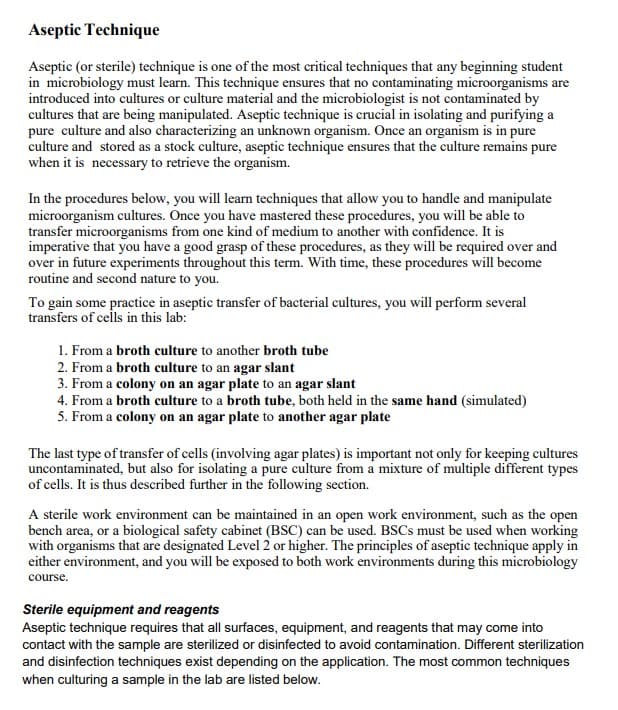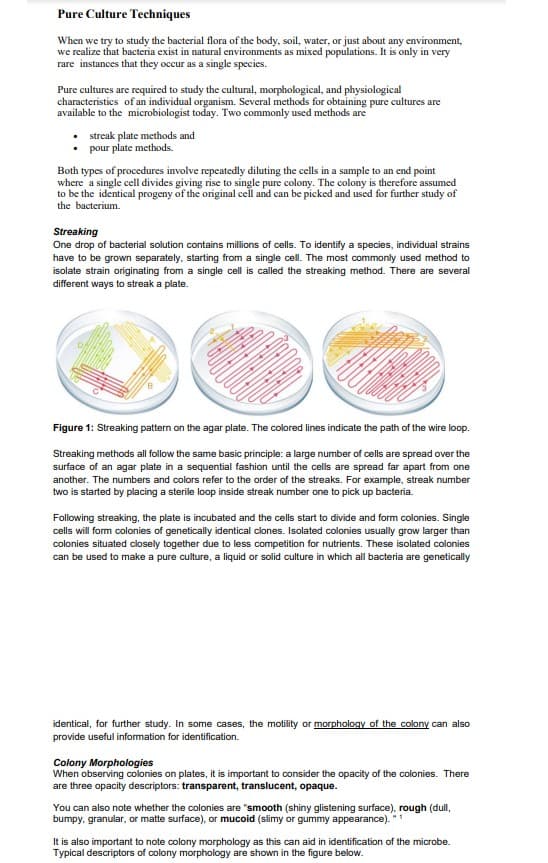Microbiology for Surgical Technologists (MindTap Course List)
2nd Edition
ISBN:9781111306663
Author:Margaret Rodriguez, Paul Price
Publisher:Margaret Rodriguez, Paul Price
Chapter4: The Prokaryotes
Section: Chapter Questions
Problem 2UTM: A surgical technologist working in the Central Sterile Processing Department is asked to run the...
Related questions
Question
Please make an aseptic technique and pure culture technique flowchart

Transcribed Image Text:Aseptic Technique
Aseptic (or sterile) technique is one of the most critical techniques that any beginning student
in microbiology must learn. This technique ensures that no contaminating microorganisms are
introduced into cultures or culture material and the microbiologist is not contaminated by
cultures that are being manipulated. Aseptic technique is crucial in isolating and purifying a
pure culture and also characterizing an unknown organism. Once an organism is in pure
culture and stored as a stock culture, aseptic technique ensures that the culture remains pure
when it is necessary to retrieve the organism.
In the procedures below, you will learn techniques that allow you to handle and manipulate
microorganism cultures. Once you have mastered these procedures, you will be able to
transfer microorganisms from one kind of medium to another with confidence. It is
imperative that you have a good grasp of these procedures, as they will be required over and
over in future experiments throughout this term. With time, these procedures will become
routine and second nature to you.
To gain some practice in aseptic transfer of bacterial cultures, you will perform several
transfers of cells in this lab:
1. From a broth culture to another broth tube
2. From a broth culture to an agar slant
3. From a colony on an agar plate to an agar slant
4. From a broth culture to a broth tube, both held in the same hand (simulated)
5. From a colony on an agar plate to another agar plate
The last type of transfer of cells (involving agar plates) is important not only for keeping cultures
uncontaminated, but also for isolating a pure culture from a mixture of multiple different types
of cells. It is thus described further in the following section.
A sterile work environment can be maintained in an open work environment, such as the open
bench area, or a biological safety cabinet (BSC) can be used. BSCS must be used when working
with organisms that are designated Level 2 or higher. The principles of aseptic technique apply in
either environment, and you will be exposed to both work environments during this microbiology
course.
Sterile equipment and reagents
Aseptic technique requires that all surfaces, equipment, and reagents that may come into
contact with the sample are sterilized or disinfected to avoid contamination. Different sterilization
and disinfection techniques exist depending on the application. The most common techniques
when culturing a sample in the lab are listed below.

Transcribed Image Text:Pure Culture Techniques
When we try to study the bacterial flora of the body, soil, water, or just about any environment,
we realize that bacteria exist in natural environments as mixed populations. It is only in very
rare instances that they occur as a single species.
Pure cultures are required to study the cultural, morphological, and physiological
characteristics of an individual organism. Several methods for obtaining pure cultures are
available to the microbiologist today. Two commonly used methods are
streak plate methods and
pour plate methods.
Both types of procedures involve repeatedly diluting the cells in a sample to an end point
where a single cell divides giving rise to single pure colony. The colony is therefore assumed
to be the identical progeny of the original cell and can be picked and used for further study of
the bacterium.
Streaking
One drop of bacterial solution contains millions of cells. To identify a species, individual strains
have to be grown separately, starting from a single cell. The most commonly used method to
isolate strain originating from a single cell is called the streaking method. There are several
different ways to streak a plate.
Figure 1: Streaking pattern on the agar plate. The colored lines indicate the path of the wire loop.
Streaking methods all follow the same basic principle: a large number of cells are spread over the
surface of an agar plate in a sequential fashion until the cells are spread far apart from one
another. The numbers and colors refer to the order of the streaks. For example, streak number
two is started by placing a sterile loop inside streak number one to pick up bacteria.
Following streaking, the plate is incubated and the cells start to divide and form colonies. Single
cells will form colonies of genetically identical clones. Isolated colonies usually grow larger than
colonies situated closely together due to less competition for nutrients. These isolated colonies
can be used to make a pure culture, a liquid or solid culture in which all bacteria are genetically
identical, for further study. In some cases, the motility or morphology of the colony can also
provide useful information for identification.
Colony Morphologies
When observing colonies on plates, it is important to consider the opacity of the colonies. There
are three opacity descriptors: transparent, translucent, opaque.
You can also note whether the colonies are "smooth (shiny glistening surface), rough (dull,
bumpy, granular, or matte surface), or mucoid (slimy or gummy appearance)."
It is also important to note colony morphology as this can aid in identification of the microbe.
Typical descriptors of colony morphology are shown in the figure below.
Expert Solution
This question has been solved!
Explore an expertly crafted, step-by-step solution for a thorough understanding of key concepts.
This is a popular solution!
Trending now
This is a popular solution!
Step by step
Solved in 4 steps with 2 images

Knowledge Booster
Learn more about
Need a deep-dive on the concept behind this application? Look no further. Learn more about this topic, biology and related others by exploring similar questions and additional content below.Recommended textbooks for you

Microbiology for Surgical Technologists (MindTap …
Biology
ISBN:
9781111306663
Author:
Margaret Rodriguez, Paul Price
Publisher:
Cengage Learning

Microbiology for Surgical Technologists (MindTap …
Biology
ISBN:
9781111306663
Author:
Margaret Rodriguez, Paul Price
Publisher:
Cengage Learning